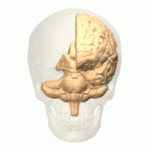Cingulate sulcus
== Cingulate Sulcus ==
The cingulate sulcus is a prominent sulcus on the medial aspect of the cerebral cortex in the brain. It is an important anatomical landmark that separates the cingulate gyrus from the superior frontal gyrus and the paracentral lobule.
Anatomy[edit | edit source]
The cingulate sulcus runs parallel to the corpus callosum, extending from the subcallosal area anteriorly to the paracentral lobule posteriorly. It is typically divided into two parts: the anterior cingulate sulcus and the posterior cingulate sulcus. The anterior part is located in the frontal lobe, while the posterior part is situated in the parietal lobe.
Function[edit | edit source]
The cingulate sulcus is closely associated with the cingulate cortex, which plays a crucial role in various cognitive and emotional processes. The cingulate cortex is involved in functions such as emotion, learning, memory, and executive function. It is also implicated in the regulation of autonomic functions and pain perception.
Clinical Significance[edit | edit source]
Abnormalities in the cingulate sulcus and the cingulate cortex have been linked to several neurological and psychiatric conditions, including schizophrenia, depression, and obsessive-compulsive disorder. Damage to this area can result in deficits in emotional processing and executive function.
Related Structures[edit | edit source]
See Also[edit | edit source]
References[edit | edit source]
External Links[edit | edit source]
This article is a neuroanatomy stub. You can help WikiMD by expanding it!
Search WikiMD
Ad.Tired of being Overweight? Try W8MD's physician weight loss program.
Semaglutide (Ozempic / Wegovy and Tirzepatide (Mounjaro / Zepbound) available.
Advertise on WikiMD
|
WikiMD's Wellness Encyclopedia |
| Let Food Be Thy Medicine Medicine Thy Food - Hippocrates |
Translate this page: - East Asian
中文,
日本,
한국어,
South Asian
हिन्दी,
தமிழ்,
తెలుగు,
Urdu,
ಕನ್ನಡ,
Southeast Asian
Indonesian,
Vietnamese,
Thai,
မြန်မာဘာသာ,
বাংলা
European
español,
Deutsch,
français,
Greek,
português do Brasil,
polski,
română,
русский,
Nederlands,
norsk,
svenska,
suomi,
Italian
Middle Eastern & African
عربى,
Turkish,
Persian,
Hebrew,
Afrikaans,
isiZulu,
Kiswahili,
Other
Bulgarian,
Hungarian,
Czech,
Swedish,
മലയാളം,
मराठी,
ਪੰਜਾਬੀ,
ગુજરાતી,
Portuguese,
Ukrainian
Medical Disclaimer: WikiMD is not a substitute for professional medical advice. The information on WikiMD is provided as an information resource only, may be incorrect, outdated or misleading, and is not to be used or relied on for any diagnostic or treatment purposes. Please consult your health care provider before making any healthcare decisions or for guidance about a specific medical condition. WikiMD expressly disclaims responsibility, and shall have no liability, for any damages, loss, injury, or liability whatsoever suffered as a result of your reliance on the information contained in this site. By visiting this site you agree to the foregoing terms and conditions, which may from time to time be changed or supplemented by WikiMD. If you do not agree to the foregoing terms and conditions, you should not enter or use this site. See full disclaimer.
Credits:Most images are courtesy of Wikimedia commons, and templates Wikipedia, licensed under CC BY SA or similar.
Contributors: Prab R. Tumpati, MD





